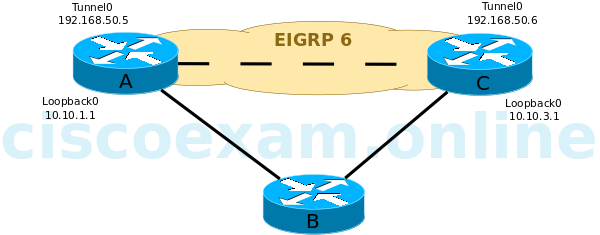
Router A:
interface Loopback0
ip address 10.10.1.1 255.255.255.0
!
interface Tunnel0
ip address 192.168.50.5 255.255.255.0
tunnel source Loopback0
tunnel destination 10.10.3.1
Router A and Router C are both configured to use Router B as a gateway of last resort. Additionally, static routes to the Loopback0 interfaces on Router A and Router C have been configured on Router B.
You configure EIGRP on Router A and then issue the show ip route command, which produces the following partial output:
Gateway of last resort is 172.15.1.2 to network 0.0.0.0
S* 0.0.0.0/0 [1/0] via 172.15.1.2
172.15.0.0/24 is subnetted, 1 subnets
C 172.15.1.0 is directly connected, Serial0/0
10.0.0.0/24 is subnetted, 2 subnets
10.10.1.0 is directly connected, Loopback0
10.10.3.0 [90/297372416] via 192.168.50.6, 00:00:01, Tunnel0
C 192.168.50.0/24 is directly connected, Tunnel0
Which of the following is true?
| A. |
The Tunnel0 interface and EIGRP adjacency on Router A will flap. | |
| B. |
The Tunnel0 interface and EIGRP adjacency on Router A will function properly. | |
| C. |
The Tunnel0 interface on Router A will function properly, but EIGRP will flap. | |
| D. |
The Tunnel0 interface on Router A will flap, but the EIGRP adjacency will function properly. |
The Tunnel0 interface and Enhanced Interior Gateway Routing Protocol (EIGRP) adjacency on Router A will flap because the preferred route to the Tunnel0 destination interface is through the tunnel itself, which results in recursive routing. When recursive routing occurs, the Tunnel0 interfaces on both RouterA and RouterC will be temporarily disabled, which breaks the EIGRP adjacency.
The EIGRP adjacency will reestablish when the tunnel interfaces return to the up state. Therefore, if you were to issue the show ip route command on RouterA while the adjacency is established, you would see that the preferred route to the Loopback0 interface on RouterC from RouterA is through Tunnel0, even though the destination interface for Tunnel0 on RouterA is the Loopback0 interface on RouterC.
If the cause of the recursive routing is not fixed, the Tunnel0 interfaces will flap and errors similar to the following will be displayed on Router A:
*Mar 1 00:26:15.379: %TUN5RECURDOWN: Tunnel0 temporarily disabled due to recursive routing
*Mar 1 00:26:16.379: %LINEPROTO5UPDOWN: Line protocol on Interface Tunnel0, changed state to down
*Mar 1 00:26:16.487: %DUAL5NBRCHANGE: IPEIGRP(0) 6: Neighbor 192.168.50.6 (Tunnel0) is down: interface down
In this scenario, an EIGRP adjacency has been established between the Tunnel0 interfaceson RouterA and RouterC. When the EIGRP adjacency comes up, the show ip route command displays Tunnel0 as the preferred route to 192.168.50.0 instead of the gateway of last resort. Therefore, the EIGRP 6 domain has been configured to include the 10.10.1.0/24 and 192.168.50.0/24 networks on RouterA and the 10.10.3.0/24 and 192.168.50.0/24 networks on RouterC. As a result, recursive routing to the 10.10.3.0 network through Tunnel0 occurs on RouterA and recursive routing to the 10.10.1.0 network occurs on RouterC. There are two ways to resolve the recursive routing issue on both RouterA and RouterC in this scenario: remove the 192.168.50.0/24 network from the EIGRP 6 domain, or add a static route to the Tunnel0 destination IP addresses on both RouterA and RouterC. A static route has a lower administrative distance (AD) than EIGRP. Therefore, a static route would fix the recursive routing problem.